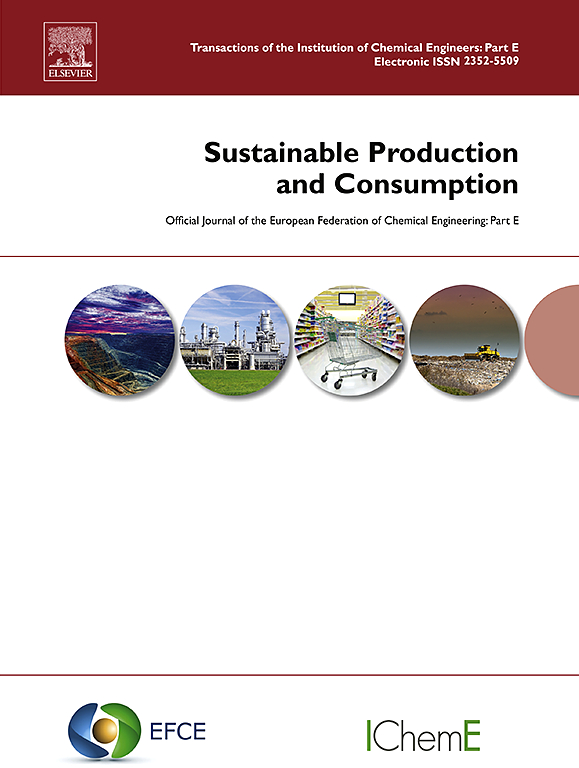中国生丝生产生命周期环境与经济评价
IF 10.9
1区 环境科学与生态学
Q1 ENVIRONMENTAL STUDIES
引用次数: 0
摘要
纺织服装业是香港重要的民生行业;尽管如此,其整个生命周期消耗的大量资源和能源对人类健康和环境产生了重大影响。本研究将生命周期影响评价与生命周期成本分析相结合,评价生丝生产从摇篮到闸门的环境和经济影响。我们的目标是确定生产链中的关键工艺和材料,并确定具有重大环境和经济影响的关键因素。结果表明,陆地生态毒性、淡水生态毒性、海洋生态毒性、人类致癌毒性和人类非致癌毒性是主要的环境影响类别。桑树种植占总环境影响的46%,成为生丝生产的主要环境负担。影响环境的关键物质包括桑树栽培中的尿素和氯化钾,养蚕中的电,缫丝过程中的蒸汽和电。经济方面,生丝生产的总成本为每公斤151.94欧元,其中内部成本为126.88欧元,外部成本为25.06欧元。缫丝是主要的成本驱动过程,占总成本的49.89%。蒸汽和人工工资是主要的成本来源,分别占总成本的43.68%和24.34%。值得注意的是,在缫丝中广泛使用蒸汽,在桑树栽培中广泛使用尿素,在养蚕中广泛使用电力,这大大增加了经济和环境负担。为了平衡环境可持续性和经济可行性,建议减少缫丝蒸汽用量,减少桑树栽培尿素用量,优化养蚕用电,提高副产品的综合利用。本文章由计算机程序翻译,如有差异,请以英文原文为准。
Life cycle environmental and economic assessment of raw silk production in China
The textile and apparel industry is an essential livelihood sector; nonetheless, its considerable resource and energy consumption throughout its life cycle substantially impacts human health and the environment. In this study, life cycle impact assessment was integrated with life cycle costing analysis to evaluate the environmental and economic impacts of raw silk production from cradle-to-gate. We aimed to identify key processes and materials in the production chain and pinpoint critical factors with substantial environmental and economic implications. The findings indicated that terrestrial ecotoxicity, freshwater ecotoxicity, marine ecotoxicity, human carcinogenic toxicity, and human non-carcinogenic toxicity were the primary environmental impact categories. Mulberry cultivation, accounting for 46 % of the total environmental impact, emerged as the principal environmental burden of raw silk production. Key materials affecting the environment included urea and potassium chloride in mulberry cultivation, electricity in silkworm farming, and steam and electricity in the silk reeling process. Economically, the total cost of raw silk production amounted to EUR 151.94 per kilogram, comprising internal costs of EUR 126.88 and external costs of EUR 25.06. Silk reeling was identified as the primary cost-driving process, accounting for 49.89 % of the total cost. Major cost contributors included steam and labor wages, which accounted for 43.68 % and 24.34 % of the total cost, respectively. Notably, the extensive use of steam in silk reeling, urea in mulberry cultivation, and electricity in silkworm farming substantially contributed to both economic and environmental burdens. To balance environmental sustainability with economic viability, it is recommended to reduce steam usage in silk reeling, minimize urea application in mulberry cultivation, optimize electricity consumption in silkworm farming, and enhance the comprehensive utilization of by-products.
求助全文
通过发布文献求助,成功后即可免费获取论文全文。
去求助
来源期刊

Sustainable Production and Consumption
Environmental Science-Environmental Engineering
CiteScore
17.40
自引率
7.40%
发文量
389
审稿时长
13 days
期刊介绍:
Sustainable production and consumption refers to the production and utilization of goods and services in a way that benefits society, is economically viable, and has minimal environmental impact throughout its entire lifespan. Our journal is dedicated to publishing top-notch interdisciplinary research and practical studies in this emerging field. We take a distinctive approach by examining the interplay between technology, consumption patterns, and policy to identify sustainable solutions for both production and consumption systems.
 求助内容:
求助内容: 应助结果提醒方式:
应助结果提醒方式:


